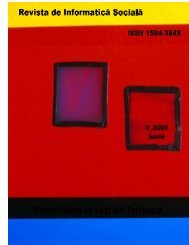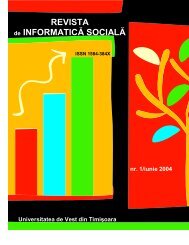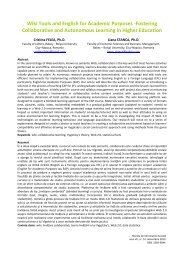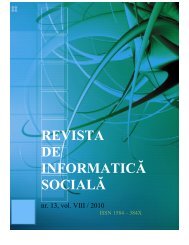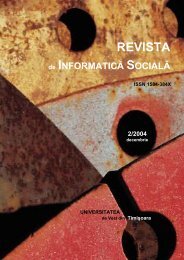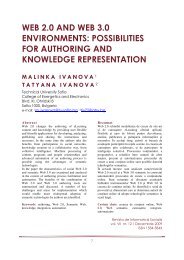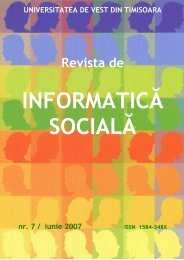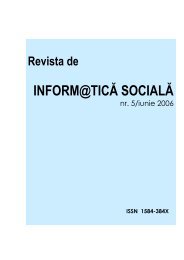(http://www.straighterline.com/partner-colleges/ace-credit-process.cfm). These sorts <strong>of</strong>relationships are the “thin tip <strong>of</strong> the wedge” in further opening up the process <strong>of</strong> gaining credit forlife experience, <strong>de</strong>monstrated competence, and/or <strong>of</strong>ferings from new, low-cost provi<strong>de</strong>rs.Stage V is a natural extension <strong>of</strong> the credit-for-prior-learning and competence-based-learningmovements. <strong>No</strong>t all institutions will have the core competences to become certification agencies forlearning. Such institutions would likely charge a certification fee for conferring a <strong>de</strong>gree forlearning achieved elsewhere, in or<strong>de</strong>r to award valued certificates or <strong>de</strong>grees. This will proveattractive as peer-to-peer and “free-range” learning opportunities <strong>de</strong>velop.Peter Smith <strong>de</strong>scribes the College for the Twenty-First Century [10] as such a place, organizedaround the needs <strong>of</strong> the learner.Summary <strong>of</strong> Stage V: Success Maker, Certifier, and Learning BrokerCharacteristics: Institutions, accrediting groups and even employers will certify credit orcompetence based on life experience and prior learning, free-range learning or learningachieved at other provi<strong>de</strong>rs. Learning brokers emerge to bundle <strong>of</strong>ferings. Learning enterprises<strong>of</strong>fer mentoring, coaching, and success making services.Transformation Impact: Further transforms the business mo<strong>de</strong>l, drives down the cost (both forparticular competences and in total) and opens the door to new services and relationships.Impact on Institutional/Learner Costs: Availability <strong>of</strong> less expensive options will drive downprices institutions can charge, thus substantially reducing learner costs.Exemplary Institutions/Participants: StraighterLine, ACE Transfer Credit, and participating institutions Western Governors University and spin-<strong>of</strong>fs (WGU Indiana) Capella University, Kaplan University, and other market-driven institutions Lamar University, UT Arlington, StateU.com.It is precisely the growth <strong>of</strong> non-institutional learning opportunities, plus new low-cost options likeStraighterLine, that illustrates the potential growth in the second vector <strong>of</strong> evolution in e-learningmethods, mo<strong>de</strong>ls and practices.Employers Will Influence the Mix. Outsi<strong>de</strong> the U.S., employers seem to be faster than in the U.S.to recognize that they can benefit from the spread <strong>of</strong> self-directed and informal learning (in whichlearners refresh their skills in their own time and on their own budget). A few U.S. employers arefollowing the global early adopters and introducing new ways <strong>of</strong> <strong>de</strong>monstrating competence, bettersuitedto global challenges that require a more agile and up-to-date workforce. This is acceleratedby enterprises like StraighterLine and its relationship with ACE and participating institutions. Whenthese changes become the norm in the U.S., a learner who is home-schooled, self-taught or educatedoutsi<strong>de</strong> <strong>of</strong> the U.S. in a non-accredited institution could take competency test/s and be granted alearning certificate or even a <strong>de</strong>gree.An interesting example is provi<strong>de</strong>d by universities working directly with employers in pr<strong>of</strong>essionalfields. By working directly with school districts Lamar University and StateU (www.stateu.com)have taken much <strong>of</strong> the market for masters <strong>de</strong>grees in education from other Texas Universities.Moreover, UT Arlington and StateU are collaborating at the RN to BSN level in nursing, workingdirectly with hospitals. StateU also serves as learning broker for un<strong>de</strong>rgraduate programs, dualenrollment (high school and college credit concurrently) and eventually high school courses. It alsoplans to <strong>of</strong>fer job placement services in future.Leading institutions that <strong>de</strong>velop the infrastructures, practices, processes, and core competences to<strong>de</strong>monstrate or certify competence will become certifying entities and/or license their practices toother institutions. This could be a lucrative business for forerunners like Capella University orWestern Governors University who have led the way in competence-based learning and
performance. In<strong>de</strong>ed, Stage V will likely be characterized by further unbundling, <strong>de</strong>constructionand reassembling <strong>of</strong> roles for participants in the learning and knowledge industry, further reflectingmany <strong>of</strong> the disruptive forces <strong>de</strong>scribed by Clayton Christenson in Disrupting Class [11].The Linkage between Learning and Employability. The linkage between learning an<strong>de</strong>mployability will be paramount for many learners. This will accelerate in the U.S. over the nextfew years, through a combination <strong>of</strong> limp recovery, limited job opportunities, and changingemployment needs. Rather than focusing on the current iconic role <strong>of</strong> “provi<strong>de</strong>r” <strong>of</strong> learning, themost nimble learning enterprises may place greater emphasis on serving as “learning agent,”integrating and brokering <strong>of</strong>ferings from themselves and others, “certifying” the competencesacquired by learners, and <strong>of</strong>fering career and life success guidance, on a continuing basis.Tomorrow’s learners, keen on achieving high-value learning and <strong>de</strong>velopment that really doesprepare them to play a significant part in increasing national productivity, may prefer to patronize<strong>de</strong>velopmental enterprises that can justly claim to be “success makers.” The most adaptive learningenterprises will likely follow the evolutionary path <strong>of</strong>:Learning Provi<strong>de</strong>r Learning Agent/Broker Certifier <strong>of</strong> Competence Success MakerThis sort <strong>of</strong> evolution will continue to shift the balance <strong>of</strong> power away from traditional colleges anduniversities, even those that have succee<strong>de</strong>d in “opening up” their approaches to learning andcompetence building. It will also stimulate new roles for new players.In particular, success making services will require spanning the boundaries between learning andwork, <strong>de</strong>ploying data mining capabilities and analytics practices to shed new light on patterns <strong>of</strong>success. Employment, temp, and workforce agencies have massive data resources, both historicand real-time. For example, Monster.com has access to over 100 M resumes and job postings thatare being scraped and analyzed to illuminate local, state, regional and national employment an<strong>de</strong>mployability matches, pathways that have been followed to success, and a myriad <strong>of</strong> otheremployability-related issues [12]. In short or<strong>de</strong>r, real-time, scalable, actionable intelligence will bebroadly available from such resources.EVOLUTION OF LEARNING SETTINGS FROM INSTITUTIONAL TO OPENThe learning settings <strong>de</strong>scribed in the first vector <strong>of</strong> transformation are institutional: Traditionalcolleges and universities (including their extension and continuing education divisions), for-pr<strong>of</strong>ituniversities, other for-pr<strong>of</strong>it learning enterprises and learning enterprises in corporations. These socalled“institutional” settings will continue to be the primary players in traditional learning. Butthey will see their dominance shrink in the face <strong>of</strong> open learning environments that are the property<strong>of</strong> the learner, not the institution.Institutions face the challenge <strong>of</strong> keeping pace with two trends: 1) the changing nature <strong>of</strong>knowledge and competence, as well as 2) the inexorable quest for greater value in learning andcompetence-building experiences. Over time, open learning with the learner at the center <strong>of</strong> apersonal learning environment (such as a free-range learner) will be the predominant mo<strong>de</strong> for thenext generation <strong>of</strong> learners over the course <strong>of</strong> their lives [17].Clear, evolutionary “stages” <strong>of</strong> open learning have not yet revealed themselves. They may emergeover time – or not. Some <strong>of</strong> the new forms <strong>of</strong> open learning environments and experiences – andtheir potential implications – are <strong>de</strong>scribed below.
- Page 1: Revista de Informatica Sociala 14 /
- Page 7: ● ● ●CONTENTS● ● ●[9-20
- Page 10 and 11: THE TRANSITION FROM OLD TO NEW MEDI
- Page 12 and 13: 30252023.420.325.11510500.85.5Never
- Page 14 and 15: Overall, we can therefore sum up on
- Page 16 and 17: n.a.I often use itI seldom use it6.
- Page 18 and 19: - Traditional web use: searching th
- Page 20 and 21: 19. Kvavik R.B., Caruso J.B. and Mo
- Page 22: IntroductionIn 1995, Bernie Dodge o
- Page 25 and 26: The Web-Inquiry Project [WIP] is a
- Page 27 and 28: and even orally. The teacher will a
- Page 29 and 30: environment in which the teacher gu
- Page 31 and 32: Transformation Through Online Learn
- Page 33 and 34: INTRODUCTIONLeading practitioners a
- Page 35 and 36: learning. We also describe how the
- Page 37 and 38: Some of these transformations are b
- Page 39 and 40: Recently, Twigg has received suppor
- Page 41 and 42: Stage III: Unbundled Learning, Mark
- Page 43: perhaps using Second Life-like virt
- Page 47 and 48: Free-Range Open LearningOver time,
- Page 49 and 50: New communities, tools and services
- Page 51 and 52: Embed enterprise-wide predictive an
- Page 53 and 54: In collaboration with Strategic Ini
- Page 55 and 56: Wiki Tools and English for Academic
- Page 57 and 58: eality. Besides being an additional
- Page 59 and 60: StudentPage 1StudentPage nTeacher
- Page 61 and 62: 100%90%80%70%60%50%40%30%20%10%0%Ac
- Page 63 and 64: 200Correlation View/Page Edits150Vi
- Page 65 and 66: 14. http://eacea.ec.europa.eu/llp/s
- Page 67 and 68: Simularea şi comunicarea electroni
- Page 69 and 70: RespondenţiRăspunsuriLa nivelul
- Page 71 and 72: RespondenţiRăspunsuriLa nivelul
- Page 73 and 74: Respondenţii au fost rugaţi să i
- Page 75 and 76: Itemul 9 doreşte să identifice ti
- Page 77 and 78: Identificara opţiunii, chiar şi p
- Page 79 and 80: EşantioaneRăspunsuri/Ranguriagita
- Page 81 and 82: modalităţile practice prin care u
- Page 83 and 84: 1. INTRODUCEREÎn prezent, complexi
- Page 85 and 86: Figura 1. Analiza grafică a evolu
- Page 87 and 88: Faţă de această situaţie se deg
- Page 89 and 90: variabilele acesti noi culturi cybe
- Page 91 and 92: INTRODUCEREÎncă din anul 2000 am
- Page 93 and 94: după tipul lecţiei: prezentare de
- Page 95 and 96:
Funcţiile oferite de AEL asigură
- Page 97 and 98:
• elevi/studenţi, beneficiari di
- Page 99 and 100:
Se poate folosi cadrul formal de co
- Page 102 and 103:
Evaluarea formativă este comentari
- Page 104 and 105:
Rezultatele elevilor, pe itemi:Diag
- Page 106 and 107:
Nr. Denumirea activităţii AEL MOO
- Page 108 and 109:
SEMNAL EDITORIALLaura MALITA, Vanna
- Page 110:
IN MEMORIAMConstantin TraianCHEVERE



